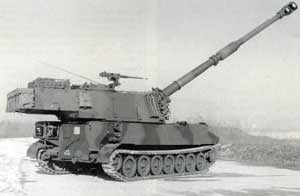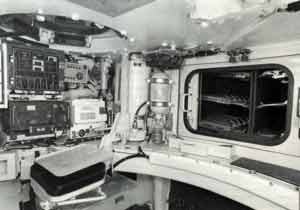| Designation: | M109L47 KAWEST |
 |
|---|---|---|
| Manufacturer: | RUAG Land Systems | |
| Product type: | Armoured Vehicles | |
| Name: | Self-propelled howitzer |
Under contract to the Swiss Defence Procurement Agency, SW Swiss Ordnance Enterprise Corporation has developed a modular upgrade programme for the US-designed 155 mm M109 series of self-propelled howitzers which are used in large numbers by the Swiss Army.
By early 1995, three prototypes of the upgraded M109 had been built by SW Swiss Ordnance Enterprise Corporation and evaluated by the Swiss Army and these were followed by five preproduction systems.
The Swiss Army has decided to upgrade a first batch of 348 existing M109 to a new standard known locally as Pz Hb 88/95, or M109 KAWEST as it is also referred to with deliveries expected to be completed by the year 2004.
In early 1998, United Defense LP of the US and SW Swiss Ordnance Enterprise Corporation signed an agreement to market on a worldwide basis a series of upgrades for the United Defense LP M109 family of 155 mm self-propelled artillery systems of which well over 4,000 have been built and with production still underway.
The main part of the upgrade is the replacement of the existing 155 mm 39 calibre barrel by a new Swiss designed and built chrome-plated 155 mm 47 calibre barrel fitted with a new double-baffle muzzle brake and fume extractor as used in the Swiss Army Pz Hb 88/95 upgrade.
This 155 mm 47 calibre ordnance is already used in the Dutch M109L47 upgrade for the United Arab Emirates.
In addition, the two companies will also market other elements of the Swiss upgrade.
United Defense LP are leading marketing of the upgrade package with SW Swiss Ordnance Enterprise Corporation providing back up. The design of the upgrade package is modular so that the user can procure only those parts required. Other subsystems can be selected, for example a different navigation and positioning system, if required by the user.
Depending on the level of upgrading required, the upgrade could be accomplished in the users' own facility, Switzerland or the US.
The 155 mm 47 calibre barrels would be provided from the Swiss production line or from the US government's Watervliet Arsenal where all US artillery and tank barrels are built.
The firing range is increased by some 60 per cent (with charge 10) by the installation of a new 47 calibre barrel which is similar to that used in the 155 mm Bison Fortress Gun.
SW Swiss Ordnance Enterprise Corporation believes that the retrofitted 155 mm 47 calibre gun is an optimal solution in terms of performance and cost-effectiveness. The recoil force of the new gun is practically unchanged and the mass which must be elevated is only 100 kg more than the original M109 barrel.
The new 155 mm 47 calibre ordnance is chrome-plated with 60 groove rifling and is fitted with a new double-baffle muzzle brake and a fume extractor.
Using charge 9, a maximum range of 23,000 m can be achieved or 30,100 m with a cargo round employing base bleed. Using charge 10, a maximum range of 26,100 m can be achieved or 36,400 m with a cargo round with base bleed. The upgraded M109 carries a total of 40 projectiles and associated charges.
A barrel temperature sensor warns of an imminent cook-off condition.
The effective engagement of fast moving targets requires a rapid rate of fire. A high firing rate is achieved for the upgraded M109 with the installation of a telescopic rammer which allows a burst rate of fire of three rounds in 15 seconds to be achieved. The semiautomatic loading rammer can be used with any 155 mm projectiles.
The telescopic rammer enables a maximum rate of fire of up to 8 rds/min.
Attached to the right side of the 155 mm weapon is a charge standby magazine which allows for the temporary stowage of four preprepared charges.
Increased sophistication in battlefield surveillance technology has shown the need for an artillery weapon which not only provides for increased range and higher firing rates but also one which has a higher mobility and must be able to 'shoot and scoot'.
The Swiss M109 navigation and gun positioning system is based on a ring laser gyro unit and supplies a continuous flow of accurate data to aid navigation and gun-laying. Computer-based command and display units for the commander, gunner and driver allow optimal fire mission management.
The vehicle is fitted with passive night vision equipment for the commander and driver to allow for 24 hour mobility.
SW Swiss Ordnance Enterprise Corporation has increased the ammunition stowage capacity of the M109 as the original load of 28 projectiles and associated charges was considered to be insufficient to accommodate the variety of ammunition used on today's battlefield and to take advantage of the firing rate of the semi-automatic loading system.
The additional 24 charges are stowed in an add-on compartment at the rear of the turret which is separated from the crew compartment by a blastproof sliding door. Doors are provided on both sides of the compartment for ammunition resupply purposes. The base and two resupply doors of the add-on compartment open easily to allow gas expulsion in case of a deflagration or explosion.
A remote-controlled hydraulic gun travel lock is another added item which allows the 155 mm ordnance to be secured from within the vehicle.
The upgraded M109 has an optimised Halon fire suppression system in the crew and driver's compartment and there is also a fire extinguishing system in the engine compartment.
As the standard electrical system of the M109 has insufficient power to satisfy the upgrade requirements, SW Swiss Ordnance Enterprise Corporation has developed and tested a new electrical system for the M109.
The upgraded electrical system provides main power with the new hull batteries and a fine power with newly added batteries with a capacity of 60 Ah.
The system is designed for ease of maintenance and repair and is over-dimensioned to provide for possible future requirements. The new alternator, which is fitted into the standard alternator mounts, is driven by the main engine and produces 80 per cent more power than the standard unit.
The power distribution system is designed with state-of-the-art electronic components to ensure a high degree of reliability. A new 16-way slip-ring developed in Switzerland transfers power and other electrical signals from the hull to the turret for best EMC conditions.
The cabling in the vehicle has also been completely redesigned and now has rugged wiring and distribution boxes. The driver's instrument panel is to a new design and the auxiliary driver display is fixed and well protected. The new instrument box contains all electronic command, control and test circuits for the entire vehicle.
All critical units of the electrical system are equipped with the appropriate test connectors for fault isolation to the LRU level by computer-supported test equipment.
|
||||||||||||||||||||||||||
|
||||||||||||||||||
 |
 |



